
views
- Pick an area of flat ground that gets at least 6 hours of sunlight a day and is close to a water source, such as a garden hose or sprinkler system.
- Mix a soil sample with water using a soil test kit. Use the color code on the kit to see which nutrients your soil is lacking. Add lime to raise pH or sulfur to lower pH, as needed.
- Shape your soil into straight, raised rows that are at least 12 inches (30 cm) apart. Some plants (like winter squash) might need more space, like 24 in (61 cm).
Choosing a Site & Testing the Soil
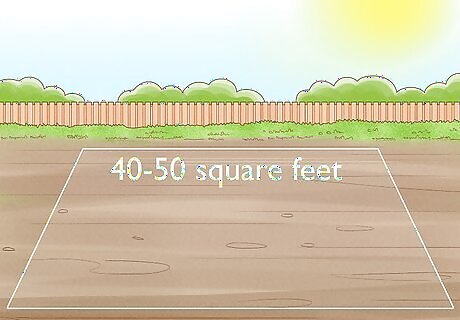
Choose an area that gets at least 6 hours of sunlight daily. Vegetables need full sunlight in order to grow healthily, which usually means getting 6 to 8 hours in the sun each day. Find a place in your yard that has enough space for the vegetables you want to grow and receives direct sunlight throughout the day. When you find a spot that you like, drive garden stakes into the four corners around the area to mark out your garden. Make sure your garden is also close to a source of water, such as your garden hose or a sprinkler system. The amount of water your plants will need will depend on the type of crop you’re growing and the soil type and texture. Consider installing a drip irrigation system to conserve water and make sure your crops will get water consistently. Be sure to choose a site that won’t be flooded by water if it rains, such as land at the bottom of a hill. Your vegetables will likely get waterlogged and possibly rot if they’re in a spot that’s easily flooded. You can make your vegetable garden any size you want but aim to have at least 40–50 square feet (3.7–4.6 m) so you have room to plant multiple vegetables.
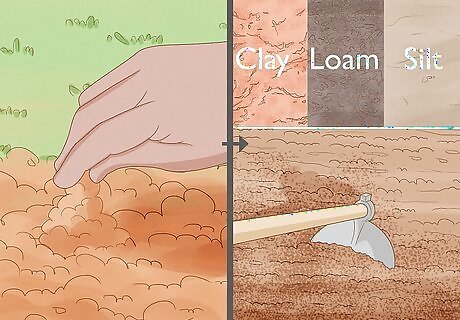
Rub a bit of soil between your fingers to test the texture. The ideal soil is a good mix of sand, silt, and clay (often called “loam”). It’ll have a smooth texture and easily crumble between your fingers. Soil that’s too sandy will feel gritty, while soil that has too much clay will be sticky and tacky between your fingers. Test the soil in multiple locations in your garden plot since the soil makeup can vary throughout. Clay soil tends to pack together tightly and therefore doesn’t drain water as well. This raises the risk of your plants getting waterlogged and their roots rotting. Sandy soil may lack the organic matter that your vegetables need to thrive, and they might dry out rapidly and require a lot more watering.
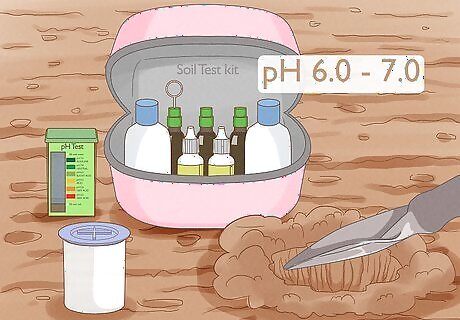
Check the nutrients of your soil with a soil test kit. To test your soil using an at-home test kit, start by digging a 6 inches (15 cm) hole in your soil and collecting a sample by skimming your shovel along the edge of the hole to get soil from each layer. Then, mix the soil together until it’s thoroughly combined. Scoop the soil into the containers provided in the kit and break open the capsules in each container. Fill the containers with water and shake them vigorously until the water changes color. Compare the colors of the water to the guide provided with the test kit to estimate the pH and nutrient levels. Most soil test kits check the pH as well as the levels of nitrogen, phosphorus, and potassium. Testing your soil every 3 to 5 years is usually enough to help you track changes. The ideal pH range for a vegetable garden is between 6.0 and 7.0. Another option is to send soil samples to a university lab or professional soil sampling company to get more accurate tests done. Testing in the early spring or late fall gives you time to prepare fertilizers and organic materials to add to the soil before you begin planting.
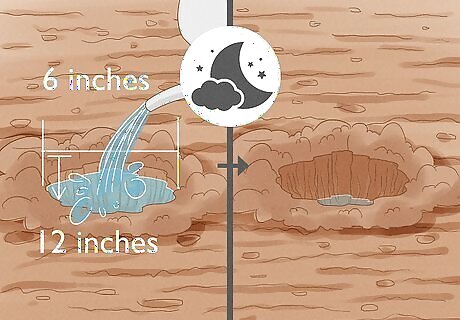
Test how fast your soil drains water. Dig a hole in your garden plot that’s 6 inches (15 cm) in diameter and 12 inches (30 cm) deep and fill it to the top with water. Let the hole drain overnight before filling it to the top again. Then, time how long it takes for the hole to completely drain the second time. Soil that drains completely between 4 to 6 hours is ideal for most plants. If the water drains completely within 3 hours, your soil might be too sandy. On the other hand, if it takes longer than 6 hours for the water to drain, your soil likely has too much clay.
Amending the Soil
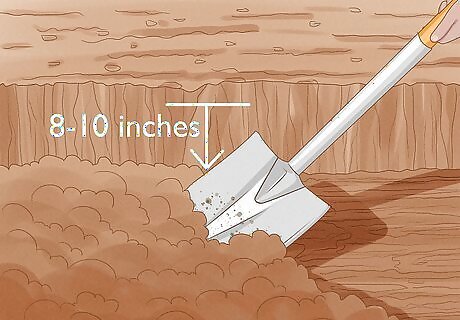
Turn over the top 8–10 inches (20–25 cm) of soil. At least 3 weeks before you plan on planting your vegetables, use a straight spade or a shovel to dig about 8–10 inches (20–25 cm) deep and move the topsoil to the bottom. Remove any sod or grass before you loosen the soil underneath. Break apart large clods of dirt until all of the soil has a fine, granular consistency that’s even throughout the entire plot so the roots of your vegetable plants have an easier time growing out. Double-dig your soil to prepare more room for roots to grow. Turn the soil over in the fall or winter before you plant so that it has enough time to dry out and is easier to work during the spring. Avoid digging up the soil when it’s wet since you might end up damaging the soil’s structure by compacting it too much. Use a motorized tiller or cultivator if you want to loosen the soil quickly. Many hardware or outdoor care stores offer daily equipment rentals.Warning: Contact your local utility companies before you start digging to make sure there aren’t any pipes or electrical wires underground in the area where you’re planning your garden.

Remove any weeds, sticks, and rocks from the soil. Use a rake to sift through your soil so you can find any weeds, large sticks, or stones that are inside your garden plot. When you pull out weeds, try to get as many of the roots out of the soil as you can or else they may grow back. Do your best to get rid of as much of the waste from your soil as you can. Avoid putting weed roots in compost bins since they could grow back and affect the quality of the compost. It’s okay if you aren’t able to remove all of the branches or rocks from your soil. At the very least, be sure to remove large objects that will obstruct the growth of your vegetables and their roots. Be cautious when using any chemicals to kill weeds or other unwanted growth in your garden plot. There’s a chance that the chemicals from weed killers and pesticides can get into the soil and affect the nutrient levels and pH.
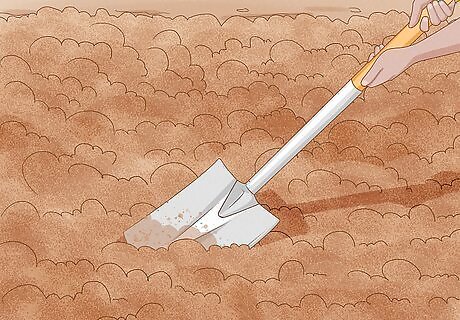
Layer 4 inches (10 cm) of organic material on top to improve the soil’s texture. Organic materials (OM) like manure, compost, peat moss, and composted sawdust can help compact sandy soil and improve drainage in clay soil. Start by applying a 2-inch (5.1-cm) layer of the compost on top of your soil and mix it in with your shovel. If you think you need more, add an additional 2 inches (5.1 cm). OM also helps supply your soil with nutrients like nitrogen. If you make your own compost, avoid using any animal or meat products in the compost bin since it can negatively affect the growth of your vegetables. Check if there are any laws where you reside regarding composting practices. Test your soil again after you add compost or manure so you can check if you need to make any more amendments. If your soil is low in OM, grow cover crops (green manure) in your garden during the fall or winter and till them into the soil just before planting season. Some types of cover crops include winter rye, winter wheat, oats, barley, and buckwheat.
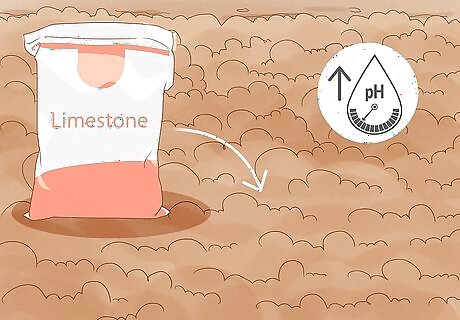
Mix lime into the soil to raise the pH. Ground limestone, commonly referred to as lime, is a basic mix that decreases the acidity in your soil. If your soil is very acidic (pH of 5.5 or lower), incorporate lime to help raise the pH. Get a hydrated lime mix and spread 2–3 pounds (0.91–1.36 kg) for every 100 square feet (9.3 m) of soil in your garden plot. Stir the lime deep into the soil to make it less acidic. It’s best to apply lime 2 to 3 months before planting.

Add 1 lb (0.45 kg) of granular sulfur per 100 square feet (9.3 m) to lower soil pH. If you accidentally added too much lime to your soil or the pH is just naturally high (above 7.0), add 1 pound (0.45 kg) of granular sulfur to your soil per 100 square feet (9.3 m). Stir the sulfur into the soil so that it’s well incorporated. Keep in mind that it can take a while to see any movement in the soil’s pH (up to a year or more), so the earlier you start, the better.

Fertilize the soil to bring up nutrient levels. An NPK fertilizer has different mixes of nitrogen, phosphorus, and potassium to help your plants get their required nutrients. Mix in 1 pound (0.45 kg) of 10-10-10 fertilizer or 2 pounds (0.91 kg) of 5-10-10 fertilizer for every 100 square feet (9.3 m) of soil in your plot. Apply the fertilizer evenly over the ground and use a shovel or spade to turn the soil and incorporate the fertilizer into the first 3 to 4 inches (7.6 to 10.2 cm) of topsoil. If your soil test kit says your nutrient levels are good or too high, avoid applying any more fertilizer since it could end up weakening your plants. Another option is to use non-mixed fertilizers when just one nutrient is lacking, such as granular nitrogen or phosphorous. Follow the directions on the packaging to determine how much to apply to your soil.
Tilling Garden Rows

Place your garden rows around 12 to 18 inches (30 to 46 cm) apart. Check the specifications on the seeds or vegetables you want to plant to see if they have special spacing requirements. Depending on the type of vegetable, they can require anywhere from 2 inches (5.1 cm) to 36 inches (91 cm) of space. Mark where you want to place the rows in your garden using stakes so you can easily form them later. For example, winter squash needs at least 24 inches (61 cm) between each plant to grow fully, while carrots only need 2 inches (5.1 cm) between each plant. Planting in rows gives your plants plenty of space to grow and also creates neat paths for you to walk down.
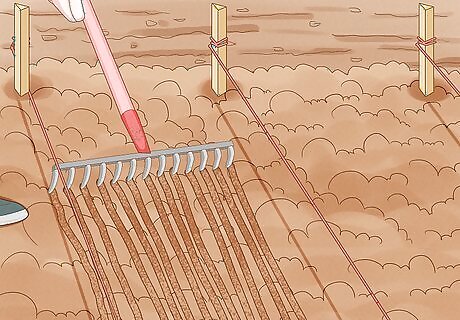
Rake your garden to form raised rows and level the tops. Run a string between two pegs or stakes that span the width of your garden and use it as a guide to form straight rows. Then, use a rake or a garden hoe to rake the soil into raised mounds that run along the string. Determine the width of your rows by looking at how much space each vegetable needs to grow. Finally, use the back of your shovel or a rake to flatten the tops of each mound so your vegetables can grow straight down. Some rows might be only 6 inches (15 cm) wide for smaller vegetables like leeks, while others will be closer to 36 inches (91 cm) to fit vegetables like summer squashes. Creating raised rows allows the soil to drain better and reduces the risk of weed infestations and soil contamination. Leave valleys between each row to create extra space between the vegetables. Look at the packaging and instructions on your vegetable seeds to see if they’ll benefit more from your rows running north to south or east to west.Tip: Avoid walking on your soil since you could compress it and make it more difficult for your plants to root. Plan out spaces where you can add footpaths to walk on while you tend to your garden.
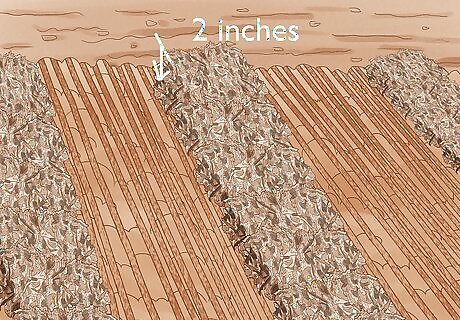
Mulch between the rows to prevent weeds from growing. Mulching your garden helps the soil retain water as well as prevents weeds from growing in your garden. Put a 2-inch (5.1 cm) layer of mulch in the valleys between your rows. Use a standard mulch mix or a different organic material, such as straw. Don’t place mulch directly on top of your rows since it’ll be difficult for your vegetables to grow through it. Another option for planting your vegetables is to create a raised bed garden. This is a good option if your soil has poor drainage, and it’ll likely put a lot less strain on your back and knees as you tend to your vegetables.















Comments
0 comment